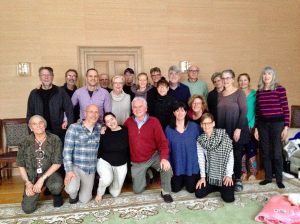Swanwick Star Issue No. 12 (2019)
Krishnamurti’s Rose Garden
This past month, a friend and I travelled to Brockwood Park for a five day intensive study/dialogue retreat on the topic:
“Death: the end of everything or the start of something new?”
As always, on this, my fourth visit, alighting at Brockwood is to breathe in deeply, the perfume, the silence, the peaceful beauty of the buildings and surrounding landscape. It is such a contrast with the hurly burly of getting there and one can always count on a warm welcome, a cup of tea and a nourishing meal, prepared largely with food from the gardens or local produce. There is, ever present, a quiet diligence of the staff and guest helpers working behind the scenes to support the visitors who are there for inquiry.
In this particular group, there were twelve of us, from divergent cultures, ages and backgrounds, which made for a rich variety of life experience. At first we knew each other not, yet by the end of the week we had become close companions. Overtly, we had our differences, but a sense of communion was developing by itself, building upon the willingness to look together at the ‘what is’ of our lives within the context of the topic. Not easy! Stephen Smith was our guide, whose competence and immersion in the teachings over very many years served us well when things started to bog down.
The days of study retreat are generously balanced at Brockwood with plenty space for personal contemplative time, or for informal dialogues. Many participants pick up K’s lead by taking an afternoon walk in the lovely countryside.
Each day we would listen to an audio or watch a video on our topic. Some of this was unpublished material. We were able to turn our chairs towards the garden whilst listening to K speaking, which I found to be a soothing combination.
It was impossible, I observed, for most to keep listening intently for an hour or more, for the completion of each topic, for every talk includes many aspects of the teachings. What worked for me, was to watch where my interest sparked. One such example was the phrase : “Look at your problems as you would look at a flower.”
During the coffee break, I wandered into the walled garden* which, in early September, is still full of roses. This provided a perfect opportunity to test out the phrase. So, I deliberately studied a particularly beautiful rose by looking with no other agenda. Possibly ten minutes or so passed before I stirred and walked along the path ready for the next step, which was to look in the same way at a problem of this life. To my astonishment, the only problem became that there were no problems!
I searched quickly through memory banks, recalling my life back home in Canada where in each day some sort of problem arises daily. I could not recall that life. At first there was a bit of panic, as in, “this is a serious senior’s moment!” Still, nothing would come. Mind was quiet, empty. Returning to the group, which I had judged previously as ‘difficult,’ there was nothing to see but love and willingness. A deep quietness pervaded my looking and listening. This remained through subsequent travel days back to Canada, which seemed to be filled with ease. It still remains, underneath the inevitable problems of ‘my’ constructed and conditioned daily life. The one I would call ‘mine’ because that is what I identify with.
One can see that the problem with problems is that they are self-generated, arising as they do, from the partial solution to the last problem. This can be seen to be true whether it’s a small personal difficulty like say losing keys, or on a societal scale such as pollution of our planet or political turmoil.
“You cannot solve a problem through the means by which it was created.”
Beyond our meddling and our fretting, that which transcends and encompasses the whole, remains.
As a result of a study group on death I have come away with life. K says death and life and love are all one. That was revealed to me without any effort of ‘mine.’ The only thing necessary was attention. This was easy with roses which assail all the senses so fully that they practically demand our attention.
Now, post Brockwood, I am able to wholeheartedly recommend the suggested activity. When beset by a problem, go and look at a flower, a tree, a bird, the ocean. Just look!
Look until there is no one looking.
*NB. Walled gardens date back to medieval times. They were called “hortus conclusus.” Entering the garden was to enter sacred space. In the centre was usually a fountain, in this particular garden, a circular pagoda. Here resided Mary of the Christian tradition, symbolizing love and compassion. Mary was also associated with the rose. Possibly the hortus conclusus at Brockwood had its origins in the medieval period, for the land is ancient. As such it will have nurtured many inquirers and contemplatives.
LW
 February Retreat with Caterina Maggi (from Italy)
February Retreat with Caterina Maggi (from Italy)

